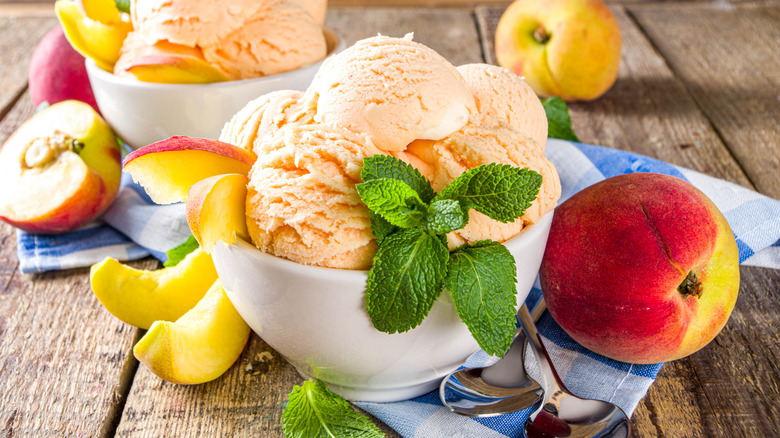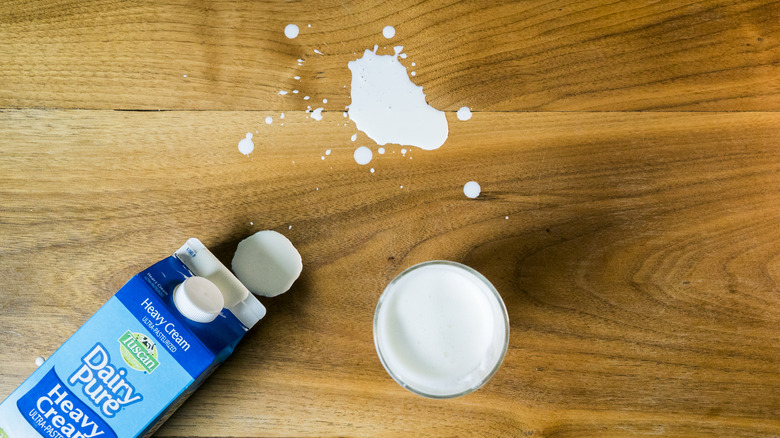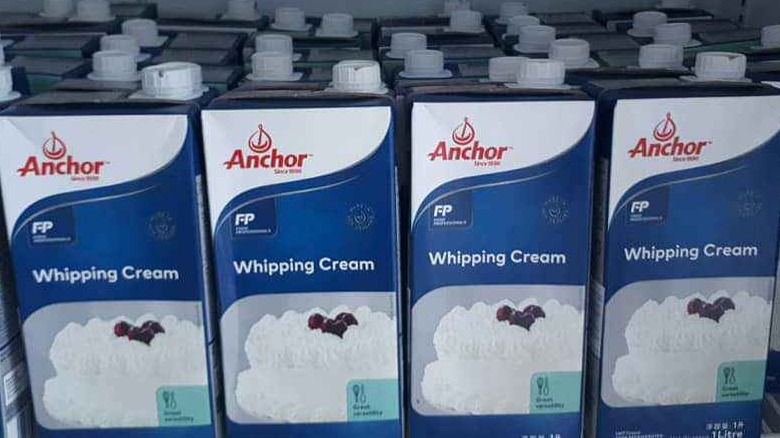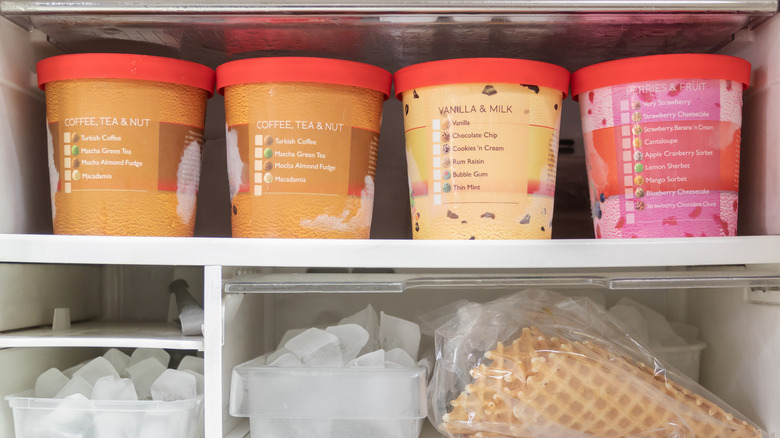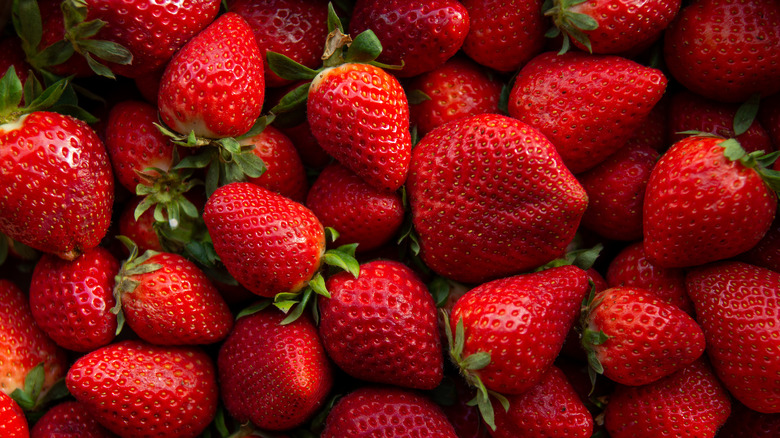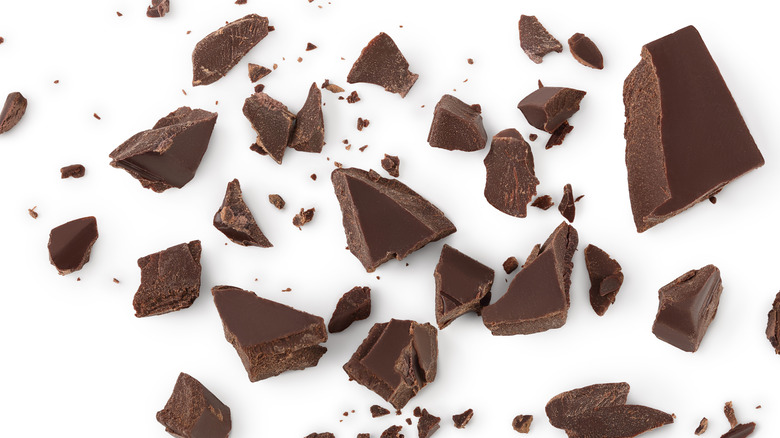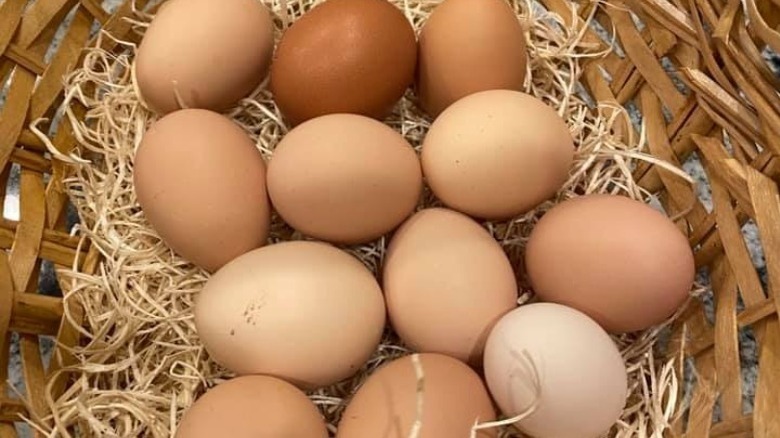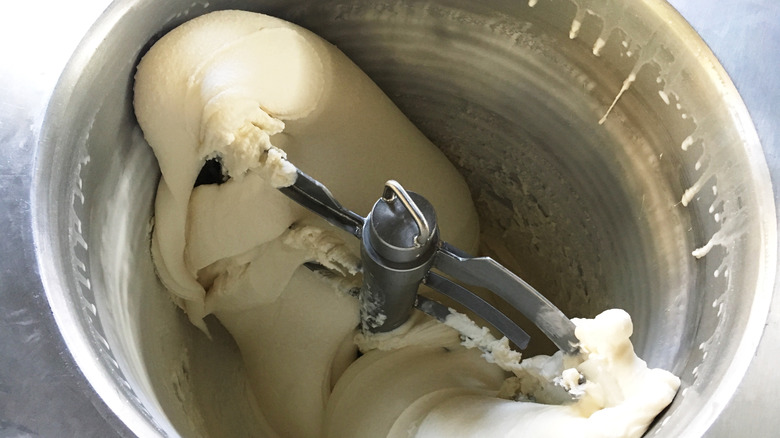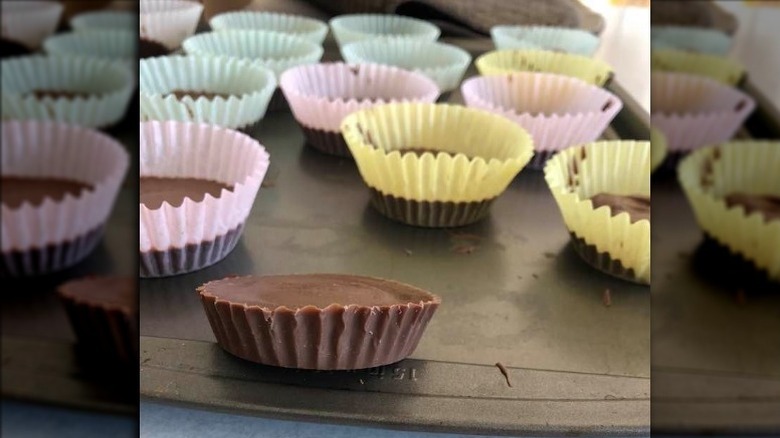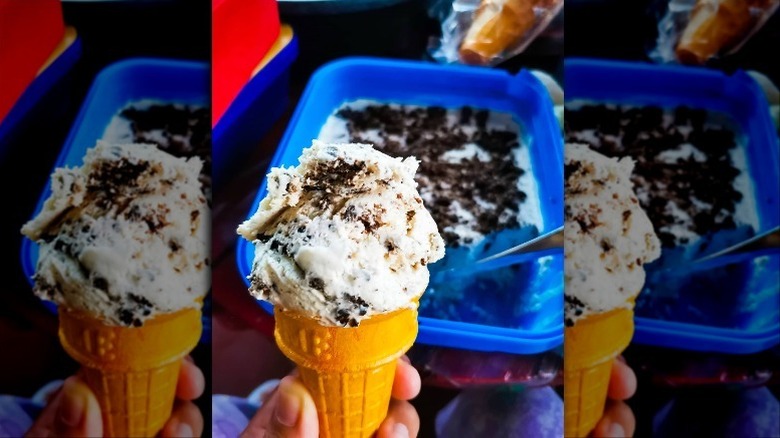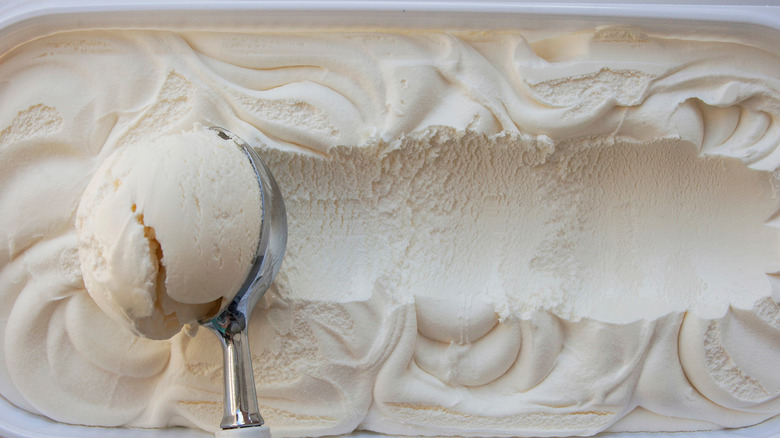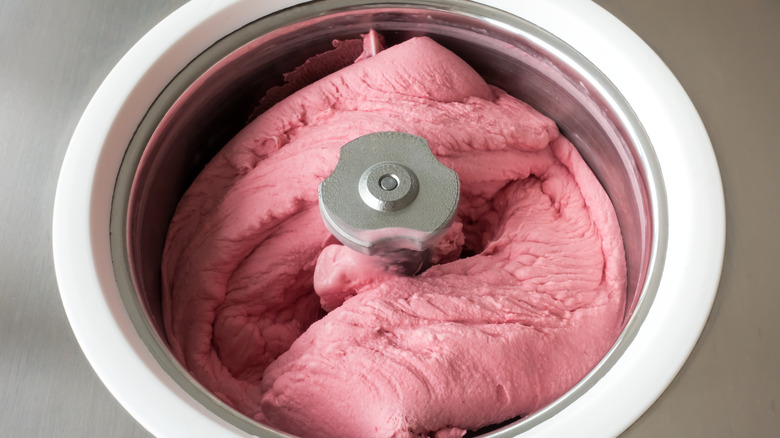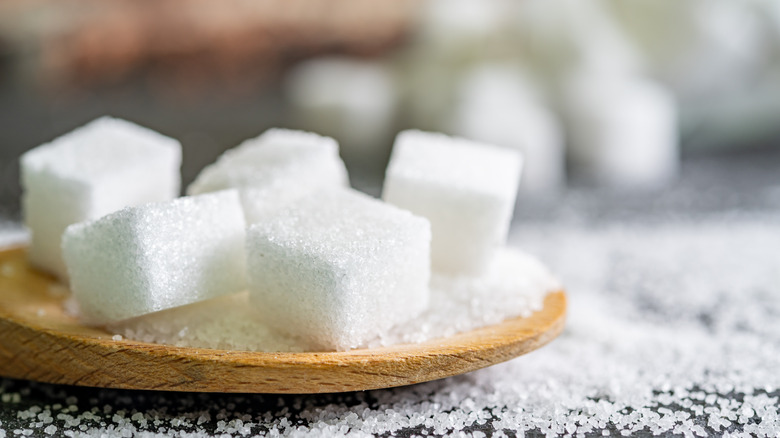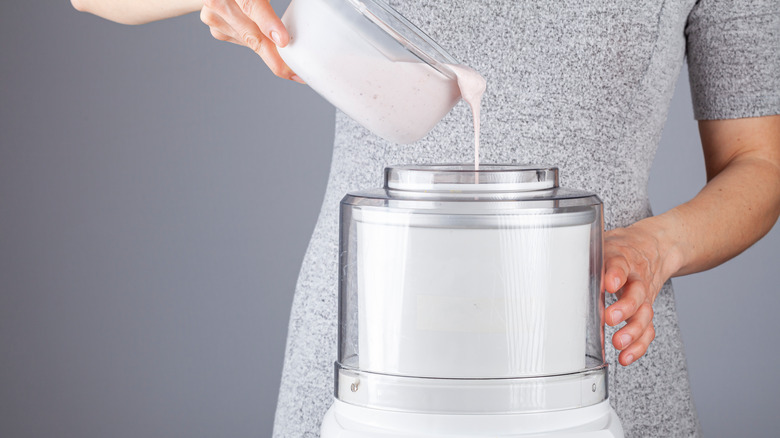Mistakes Everyone Makes With Homemade Ice Cream
For most of us, the only way to get a good serving of ice cream is to either buy a pint at the store or grab a scoop at a local ice cream shop. And sure, that works fine if you're not the kind of person who eats ice cream on the regular. If you are always on the hunt for the sweet stuff, though, you may be better off making it yourself. That way, not only do you guarantee that your ice cream is going to be as fresh as possible, but you also have the option of adding in whatever you want to the mix. Imagine the wildest ice cream you can think of, and you can probably make it if you churn your own ice cream.
Now, you can always do it the old-fashioned way, but these days, more and more people have ice cream makers at home. These machines are relatively easy to use, so just about anyone can whip up an amazing dessert. However, there are more than a few mistakes that are easy to make during the ice cream-making process. If you truly want to make the best ice cream possible, you'll want to avoid those mistakes if at all possible.
Just what should you be on the lookout for? We've compiled some of the most common homemade ice cream mistakes you should be avoiding. Happy churning!
Not using dairy products with a high-enough fat content
While we all love going out to eat, one of the best parts of cooking your own food at home is the fact that you get to see what goes into everything you consume. It's an easy way to cut down on calories, fat, carbs, or whatever else you're trying to avoid. And because of that, many people are attracted to making their own ice cream at home. After all, you can always make low-fat ice cream that everyone can enjoy, right?
You may want to think again about low-fat products when you're making ice cream. If you try to use low-fat ingredients instead of heavy cream, you're going to end up with pretty flavorless ice cream, according to Kitchn. A lot of what makes good ice cream delicious is its relatively high fat content. Taking that out is going to leave you with a bland, icy mess.
And it's not just about the flavor, either. Ice cream made with low-fat or skim milk is also going to have a difficult time freezing properly, as those fats help the mixture form smaller ice crystals that feel smoother on your tongue. Using low-fat products means that you may get those unpleasantly crunchy ice crystals you want to avoid at all costs. So, we admire your attempt to opt for a healthier dessert, but you really shouldn't skimp on the fat content when it comes to ice cream.
Using whipping cream
When you're new to making ice cream, you may not yet know which ingredients will make the best possible dessert. And since some of these ingredients can be confused with others, it's easy to make a mistake and pick up the wrong ingredient from the store simply because you're not reading closely enough. For example, if you're making your ice cream from scratch, you're going to need to find heavy cream. Heavy cream has a high fat content, which will give you that rich, smooth texture you're going for.
However, many people will confuse heavy cream and whipping cream, but they're not the same and they definitely won't work the same way in an ice cream recipe. Heavy cream contains more fat than whipping cream, for one, which is key to making good ice cream. Whipping cream is also mixed with stabilizers that you won't want in your finished product. And since it's easier to over-churn whipping cream than heavy cream, you may be left with an ice cream that has a weird, fatty finish to it that just doesn't sit right.
So, always be sure to double-check the label of the cream you buy when you're picking up your ice cream ingredients.
Forgetting to pre-freeze your mix
We get it. Sometimes, you get a random craving for ice cream and you feel like you have to have some right now. We've all been there. Unfortunately, though, homemade ice cream is something you have to think about well ahead of time and can't properly mix up at the last minute. Otherwise, it's probably not going to come out as you would prefer. That's why you need to think about the time needed to freeze your mix.
According to Food 52, ice crystal formation is one of the main problems that people run into when they're making ice cream. Too-large ice crystals generally happen when the ice cream doesn't freeze fast enough. This also means that, when you're using a machine at home, you want to make sure that everything is super-cold when you start to churn. Therefore, it just makes sense to freeze your mix ahead of time in order to get the best results.
You'll definitely want the mix to be in the freezer for at least a few hours before you start to make the ice cream, though it's generally best if it's kept in the freezer overnight. Yes, that takes some extra planning, but doing this work ahead of time will ensure that you have the creamiest, most ice-free ice cream possible.
Using low-quality add-in ingredients
When it comes to the base of your ice cream, the ingredients are relatively simple: heavy cream, eggs, and sugar. Since this ice cream base is on the simple side, it's smart to make sure that these ingredients are as high-quality as possible. If you use subpar sugar or heavy cream that's going off, you're inevitably going to be able to taste it in your finished product. This likely already goes without saying, but you're also going to want to keep that same mindset when it comes to the add-ins you choose, whether they're classic additions or more daring ice cream accompaniments.
For instance, chocolate is one of the most popular ice cream flavors, and if you're going to add chocolate to your mix, you want to make sure it's really good stuff. We think it's worth spending a bit of extra money to get the chocolate that you'd want to eat all on its own. The same principle rings true for fruit. Make sure you get fresh, ripe fruit, but also make sure you're eating fruits that are in season. This means that a classic like strawberry ice cream is going to taste the best in the middle of the summer when the fruits are harvested at their peak.
By really prioritizing the add-ins you choose, you're going to make the best possible batch of ice cream. So, don't skimp on the quality of these ingredients.
Adding in your mix-in ingredients before you churn
Making ice cream is clearly a bit of a process, so you're likely looking for ways to cut corners whenever possible. So, when you're preparing your mix, it may seem like a good idea to add your mix-ins right then and there. It would be so easy after all, and how much harm can it really do?
However, if you do this, you're putting yourself at a serious disadvantage. As Bon Appétit notes, some ingredients are going to freeze and harden to an unpleasant consistency if you put them in ahead of time. Just think: Do you really want to bite into a frozen peanut or piece of chocolate and break your tooth? We didn't think so. And if you're using chunks of fruit, make sure they're cut small enough so you don't have to bite into them when they're freezing cold.
Even with softer items like jam or a fudge swirl, it's best to add in your extra ingredients after your ice cream has finished churning. Just fold the mix-in into the batch then and put it in the freezer. It seems like a small difference, but it definitely counts when it comes to taste and texture.
Not using the freshest eggs possible
We've already talked about how important it is to make sure you're using high-quality mix-ins. But you may not realize that there's another part of the ingredients list that you'll want to make sure is absolutely as fresh as possible: the eggs. According to King Arthur Baking, eggs add a lot of weight and flavor to homemade ice cream, so this is clearly not an ingredient that you want to skip. But did you know that it's of the utmost importance that you're using the freshest possible eggs?
Eggs also function as an emulsifier, an ingredient that helps water and fat mix together into one cohesive whole. Given the amount of water and fat that goes into ice cream, having a high-quality emulsifier is pretty key. However, the longer an egg sits in your fridge, the more the lecithin content inside declines. When this happens, it becomes a less effective emulsifier and can lead to icier and less smooth ice cream.
Therefore, when you're making your ice cream, make sure you pick out the freshest eggs possible right before you get started. You're likely to notice a big difference in the quality of your ice cream.
Not freezing your ice cream maker bowl
We've already talked about making sure that your ice cream freezes quickly enough to get the right texture, which you need to achieve by the time you get ready to start churning. And while making sure your ice cream mix is frozen ahead of time takes care of a lot of that work, it's not the only step you need to take to ensure you're making the freshest possible ice cream. In addition to freezing the mix, you'll also want to freeze your ice cream maker bowl, according to Kitchn.
You're not just going to want to chill this bowl, though. You need it to be completely frozen. This will involve you sticking the bowl in your freezer for about a full day before you plan on using it. Are you afraid you're not going to remember to put it in the freezer until it's already too late? We've got a solution for that. Just place it in a zip-top bag and store it in the freezer, assuming you've got the freezer space available. Then, the next time you're ready to use your ice cream maker, you can just take the bowl out and get on with the rest of the process.
Refusing to make your own add-ins
Have you encountered this ice cream-making problem before? It seems like you were doing everything right, at least at first. You froze your bowl and your mix ahead of time. You made sure that you don't add in your extra ingredients until you're done churning. Then you froze the finished product, and when it came out of the freezer, you're still left with super-frozen add-ins. Those ingredients have that iciness to them that you were trying to avoid at all costs.
Sound familiar? It's a common problem, and that's because many of the add-ins you may consider using aren't actually designed to be frozen. While a Reese's peanut butter cup is delicious, the chocolate and other ingredients mean that it's not going to taste great when you break it up and put it in the freezer.
Therefore, you may want to consider simply making your own add-ins. That way, you can make them more able to stand up to the harsh environment of the freezer. For example, if you're making ice cream with bits of chocolate in it, preparing that chocolate with some coconut oil added into the mix will ensure it freezes more easily, preventing that dreaded icy texture. It may take some extra time and effort, but you'll be more pleased with the results.
Freezing all of your ice cream in one block
When you buy your ice cream at the grocery store, it all comes in one brick. A gallon is a lot of ice cream, after all. However, when it comes to homemade ice cream, you really don't want to store it the same way. Often, the ice cream you make at home will be harder in consistency than the stuff you buy at the store. Therefore, if you store it in one huge block, it may be difficult to scoop when you're ready to enjoy it straight out of the freezer. If you're using natural fruit in your ice cream, it can make this process even more difficult because there's more water in the mix that will also contribute to the texture of the finished ice cream.
You can and should thaw the ice cream a bit, but that can get tricky if it's all in one giant block. The solution? Simply portion your ice cream out ahead of time. That way, when you take it out of the freezer, it won't have to thaw for quite so long. Plus, that'll keep you from eating all of it at once — something we've all been guilty of at one time or another.
Trying to keep your homemade ice cream for too long
When you buy ice cream from the store, it can last in your freezer for weeks. If you don't tend to eat a lot of ice cream, this is perfect, as you can always come back to it later. But when you're making homemade ice cream, you don't really have that same luxury. Have you ever made a delicious batch of ice cream only to save it for a few days and then come back to an icy, sugary mess? You're not alone.
While we wish there were a better solution for this problem, it's just a fact that homemade ice cream doesn't last as long as the store-bought stuff, as Food52 reports. Since it doesn't have all those stabilizers you'll find in commercially produced ice cream, it's not going to last for very long, even if you keep it frozen in the freezer. Therefore, the best solution is simply to eat your ice cream quickly. Can't finish it all yourself? Invite some friends over to share it with you — they'll probably be more than happy to help.
Churning your ice cream for too long
If you're new to the ice cream-making game, you'll probably want to watch your ice cream harden while it's being churned in the machine. After all, you're probably dying to dig into it and you don't want to wait any longer than you have to. Therefore, when it doesn't come out as firm as you want, you may think it's a good idea to leave it in the ice cream maker for longer. However, we're sorry to tell you that more churning does not equal firmer ice cream, according to Kitchn. Rather, it'll just leave you with a batch of ice cream full of those nasty ice crystals.
Instead of over-churning your homemade ice cream and ruining the texture, you should just place your freshly churned ice cream into the freezer when it's done churning. So, practice a bit of patience, leave it in the fridge for a few hours, and you'll soon have the firm, frozen ice cream of your dreams.
Using the incorrect amount of sugar
There are many different recipes out there that you can follow to get a delicious batch of ice cream. Really, it all comes down to what you want to add to the mix and what flavor you think would best complement those add-ins. But once you pick a recipe, you'll want to stick to it, especially when it comes to the amount of sugar you add to the mix. Why? Because sugar plays an important role in how the consistency of your ice cream turns out.
If you use too much sugar, your ice cream is likely to harden too much and will make for a truly unpleasant and potentially sweat-inducing experience as you try to dig into the treat. On the other hand, using too little sugar will result in an ice cream consistency that's too soft to truly enjoy. But stick with a recipe you trust, measure out your sugar accurately, and you shouldn't encounter this kind of problem.
Overfilling your ice cream machine
We get it. If you have a craving for ice cream, you may not just want a spoonful. Rather, you may be looking for a big bowl of the sweet stuff. That's totally understandable, but that doesn't mean you should let your eyes get bigger than your stomach — or your brain, for that matter. That's because those who know how to make homemade ice cream well will tell you that overfilling your ice cream machine is a big mistake.
If you fill it up too much, the mixture is liable to spill over the sides, and we probably don't have to tell you that just such a situation is going to make a huge mess. Who wants to clean up the sticky mix from your counter? It may also prevent the ice cream from getting properly aerated, which could result in a final mixture that's too dense instead of having that light, relatively fluffy texture you were going for.
Generally, you'll want to fill your ice cream maker bowl about three-quarters of the way full for the best results. If you really want to make more, you'll have to plan ahead and make more than one batch in sequence.
